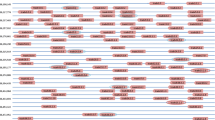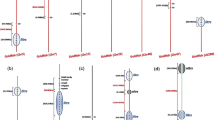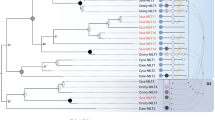Abstract
In teleost fish, a novel gene G6F-like was identified, encoding a type I transmembrane molecule with four extracellular Ig-like domains and a cytoplasmic tail with putative tyrosine phosphorylation motifs including YxN and an immunoreceptor tyrosine-based activation motif (ITAM). G6F-like maps to a teleost genomic region where stretches corresponding to human chromosomes 6p (with the MHC), 12p (with CD4 and LAG-3), and 19q are tightly linked. This genomic organization resembles the ancestral “Ur-MHC” proposed for the jawed vertebrate ancestor. The deduced G6F-like molecule shows sequence similarity with members of the CD4/LAG-3 family and with the human major histocompatibility complex-encoded thrombocyte marker G6F. Despite some differences in molecular organization, teleost G6F-like and tetrapod G6F seem orthologous as they map to similar genomic location, share typical motifs in transmembrane and cytoplasmic regions, and are both expressed by thrombocytes/platelets. In the crucian carps goldfish (Carassius auratus auratus) and ginbuna (Carassius auratus langsdorfii), G6F-like was found expressed not only by thrombocytes but also by erythrocytes, supporting that erythroid and thromboid cells in teleost fish form a hematopoietic lineage like they do in mammals. The ITAM-bearing of G6F-like suggests that the molecule plays an important role in cell activation, and G6F-like expression by erythrocytes suggests that these cells have functional overlap potential with thrombocytes.









Similar content being viewed by others
References
Akashi K, Traver D, Miyamoto T, Weissman IL (2000) A clonogenic common myeloid progenitor that gives rise to all myeloid lineages. Nature 404:193–197
Amigo JD, Ackermann GE, Cope JJ et al (2009) The role and regulation of friend of GATA-1 (FOG-1) during blood development in the zebrafish. Blood 114:4654–4663
Barber EK, Dasgupta JD, Schlossman SF, Trevillyan JM, Rudd CE (1989) The CD4 and CD8 antigens are coupled to a protein-tyrosine kinase (p56lck) that phosphorylates the CD3 complex. Proc Natl Acad Sci USA 86:3277–3281
Beck S, The MHC Consortium et al (1999) Complete sequence and gene map of a human major histocompatibility complex. The MHC sequencing consortium. Nature 401:921–923
Belele CL, English MA, Chahal J et al (2009) Differential requirement for Gata1 DNA binding and transactivation between primitive and definitive stages of hematopoiesis in zebrafish. Blood 114:5162–5172
Belov K, Deakin JE, Papenfuss AT et al (2006) Reconstructing an ancestral mammalian immune supercomplex from a marsupial major histocompatibility complex. PLoS Biol 4:e46
Carradice D, Lieschke GJ (2008) Zebrafish in hematology: sushi or science? Blood 111:3331–3342
Chakraborty A, Dyer KF, Cascio M, Mietzner TA, Tweardy DJ (1999) Identification of a novel Stat3 recruitment and activation motif within the granulocyte colony-stimulating factor receptor. Blood 93:15–24
Chang CF, Hamilton PB (1979) The thrombocyte as the primary circulating phagocyte in chickens. J Reticuloendothel Soc 25:585–590
Daëron M, Jaeger S, Du Pasquier L, Vivier E (2008) Immunoreceptor tyrosine-based inhibition motifs: a quest in the past and future. Immunol Rev 224:11–43
Debili N, Coulombel L, Croisille L et al (1996) Characterization of a bipotent erythro-megakaryocytic progenitor in human bone marrow. Blood 88:1284–1296
Desai S, Heffelfinger AK, Orcutt TM, Litman GW, Yoder JA (2008) The medaka novel immune-type receptor (NITR) gene clusters reveal an extraordinary degree of divergence in variable domains. BMC Evol Biol 18:177
Detrich HW 3rd, Kieran MW, Chan FY (1995) Intraembryonic hematopoietic cell migration during vertebrate development. Proc Natl Acad Sci USA 92:10713–10717
De Vet EC, Aguado B, Campbell RD (2003) Adaptor signalling proteins Grb2 and Grb7 are recruited by human G6f, a novel member of the immunoglobulin superfamily encoded in the MHC. Biochem J 375:207–213
Dijkstra JM, Somamoto T, Moore L, Hordvik I, Ototake M, Fischer U (2006) Identification and characterization of a second CD4-like gene in teleost fish. Mol Immunol 43:410–419
Dijkstra JM, Katagiri T, Hosomichi K, Yanagiya K, Inoko H, Ototake M, Aoki T, Hashimoto K, Shiina T (2007) A third broad lineage of major histocompatibility complex (MHC) class I in teleost fish; MHC class II linkage and processed genes. Immunogenetics 59:305–321
Engels N, König LM, Heemann C et al (2009) Recruitment of the cytoplasmic adaptor Grb2 to surface IgG and IgE provides antigen receptor-intrinsic costimulation to class-switched B cells. Nat Immunol 10:1018–1025
Flajnik MF, Du Pasquier L (2008) Evolution of the immune system. In: Paul WE (ed) Fundamental immunology, 6th edn. Lippincott-Williams, Philadelphia, pp 56–124
Flajnik MF, Kasahara M (2010) Origin and evolution of the adaptive immune system: genetic events and selective pressures. Nat Rev Genet 11:47–59
Freeman-Cook LL, Edwards AP, Dixon AM et al (2005) Specific locations of hydrophilic amino acids in constructed transmembrane ligands of the platelet-derived growth factor beta receptor. J Mol Biol 345:907–921
García A, Senis YA, Antrobus R et al (2006) A global proteomics approach identifies novel phosphorylated signaling proteins in GPVI-activated platelets: involvement of G6f, a novel platelet Grb2-binding membrane adapter. Proteomics 6:5332–5243
Gilbert W (1978) Why genes in pieces? Nature 271:501
Glomski CA, Tamburlin J, Chainani M (1992) The phylogenetic odyssey of the erythrocyte. III. Fish, the lower vertebrate experience. Histol Histopathol 7:501–528
Guselnikov SV, Najakshin AM, Taranin AV (2003) Fugu rubripes possesses genes for the entire set of the ITAM-bearing transmembrane signal subunits. Immunogenetics 55:472–479
Halaby DM, Poupon A, Mornon J (1999) The immunoglobulin fold family: sequence analysis and 3D structure comparisons. Protein Eng 12:563–571
Hallböök F, Wilson K, Thorndyke M, Olinski RP (2006) Formation and evolution of the chordate neurotrophin and Trk receptor genes. Brain Behav Evol 68:133–144
Han DC, Shen TL, Guan JL (2001) The Grb7 family proteins: structure, interactions with other signaling molecules and potential cellular functions. Oncogene 20:6315–6321
Harpaz Y, Chothia C (1994) Many of the immunoglobulin superfamily domains in cell adhesion molecules and surface receptors belong to a new structural set which is close to that containing variable domains. J Mol Biol 238:528–539
Humphrey MB, Lanier LL, Nakamura MC (2005) Role of ITAM-containing adapter proteins and their receptors in the immune system and bone. Immunol Rev 208:50–65
Jagadeeswaran P, Sheehan JP, Craig FE, Troyer D (1999) Identification and characterization of zebrafish thrombocytes. Br J Haematol 107:731–738
Jagadeeswaran P, Kulkarni V, Carrillo M, Kim S (2007) Zebrafish: from hematology to hydrology. J Thromb Haemost 5(Suppl 1):300–304
Jagadeeswaran P, Lin S, Weinstein B, Hutson A, Kim S (2010) Loss of GATA1 and gain of FLI1 expression during thrombocyte maturation. Blood Cells Mol Dis 44:175–180
Jaillon O, Aury JM, Brunet F et al (2004) Genome duplication in the teleost fish Tetraodon nigroviridis reveals the early vertebrate proto-karyotype. Nature 431:946–957
Jang IK, Gold HK, Ziskind AA et al (1989) Differential sensitivity of erythrocyte-rich and platelet-rich arterial thrombi to lysis with recombinant tissue-type plasminogen activator. A possible explanation for resistance to coronary thrombolysis. Circulation 79:920–928
Janzarik H, Morgenstern E (1979) The nucleated thrombocytoid cells. I. Electron microscopic studies on chicken blood cells. Thromb Haemost 41:608–621
Kammerer R, Zimmermann W (2010) Coevolution of activating and inhibitory receptors within mammalian carcinoembryonic antigen families. BMC Biol 8:12
Kammerer R, Popp T, Härtle S, Singer BB, Zimmermann W (2007) Species-specific evolution of immune receptor tyrosine based activation motif-containing CEACAM1-related immune receptors in the dog. BMC Evol Biol 7:196
Kasahara M (1999) The chromosomal duplication model of the major histocompatibility complex. Immunol Rev 167:17–32
Kasahara M, Naruse K, Sasaki S et al (2007) The medaka draft genome and insights into vertebrate genome evolution. Nature 447:714–719
Kasirer-Friede A, Kahn ML, Shattil SJ (2007) Platelet integrins and immunoreceptors. Immunol Rev 218:247–264
Kelley J, Walter L, Trowsdale J (2005) Comparative genomics of natural killer cell receptor gene clusters. PLoS Genet 1:129–139
Kfoury JR Jr, Nakayasu C, Rodrigues Souza JC, Okamoto N (1999) Characterization of a monoclonal antibody specific to rainbow trout thrombocytes. J Exp Zool 284:309–316
Kim PW, Sun ZY, Blacklow SC, Wagner G, Eck MJ (2003) A zinc clasp structure tethers Lck to T cell coreceptors CD4 and CD8. Science 301:1725–1728
Köllner B, Fischer U, Rombout JH, Taverne-Thiele JJ, Hansen JD (2004) Potential involvement of rainbow trout thrombocytes in immune functions: a study using a panel of monoclonal antibodies and RT-PCR. Dev Comp Immunol 28:1049–1062
Laing KJ, Zou JJ, Purcell MK, Phillips R, Secombes CJ, Hansen JD (2006) Evolution of the CD4 family: teleost fish possess two divergent forms of CD4 in addition to lymphocyte activation gene-3. J Immunol 177:3939–3951
Li N, Workman CJ, Martin SM, Vignali DA (2004) Biochemical analysis of the regulatory T cell protein lymphocyte activation gene-3 (LAG-3; CD223). J Immunol 173:6806–6812
Lin HF, Traver D, Zhu H, Dooley K, Paw BH, Zon LI, Handin RI (2005) Analysis of thrombocyte development in CD41-GFP transgenic zebrafish. Blood 106:3803–3810
Lyons SE, Lawson ND, Lei L, Bennett PE, Weinstein BM, Liu PP (2002) A nonsense mutation in zebrafish gata1 causes the bloodless phenotype in vlad tepes. Proc Natl Acad Sci USA 99:5454–5459
Macaulay IC, Tijssen MR, Thijssen-Timmer DC et al (2007) Comparative gene expression profiling of in vitro differentiated megakaryocytes and erythroblasts identifies novel activatory and inhibitory platelet membrane proteins. Blood 109:3260–3269
Nonaka M, Matsuo M, Naruse K, Shima A (2001) Comparative genomics of medaka: the major histocompatibility complex (MHC). Mar Biotechnol (NY) 3(Supplement 1):S141–S144
Ohta Y, Okamura K, McKinney EC, Bartl S, Hashimoto K, Flajnik MF (2000) Primitive synteny of vertebrate major histocompatibility complex class I and class II genes. Proc Natl Acad Sci USA 97:4712–4717
Ohta Y, Goetz W, Hossain MZ, Nonaka M, Flajnik MF (2006) Ancestral organization of the MHC revealed in the amphibian Xenopus. J Immunol 176:3674–3685
Pancer Z, Mayer WE, Klein J, Cooper MD (2004) Prototypic T cell receptor and CD4-like coreceptor are expressed by lymphocytes in the agnathan sea lamprey. Proc Natl Acad SciUSA 101:13273–13278
Parise LV, Smyth SS, Shet AS, Coller BS (2006) Platelet morphology, biochemistry and function. In: Lichtman MA, Kipps TJ, Kaushansky K, Beutler E, Seligsohn U, Prchal JT (eds) Williams hematology, 7th edn. McGraw-Hill, New York, pp 1587–1664
Pischel KD, Bluestein HG, Woods VL Jr (1988) Platelet glycoproteins Ia, Ic, and IIa are physicochemically indistinguishable from the very late activation antigens adhesion-related proteins of lymphocytes and other cell types. J Clin Invest 81:505–513
Panagos PG, Dobrinski KP, Chen X, Grant AW, Traver D, Djeu JY, Wei S, Yoder JA (2006) Immune-related, lectin-like receptors are differentially expressed in the myeloid and lymphoid lineages of zebrafish. Immunogenetics 58:31–40
Pratt SJ, Drejer A, Foott H, Barut B, Brownlie A, Postlethwait J, Kato Y, Yamamoto M, Zon LI (2002) Isolation and characterization of zebrafish NFE2. Physiol Genomics 11:91–98
Putnam NH, Butts T, Ferrier DE et al (2008) The amphioxus genome and the evolution of the chordate karyotype. Nature 453:1064–1071
Read LR, Raynard SJ, Ruksc A, Baker MD (2004) Gene repeat expansion and contraction by spontaneous intrachromosomal homologous recombination in mammalian cells. Nucleic Acids Res 32:1184–1196
Ribas G, Neville M, Wixon JL, Cheng J, Campbell RD (1999) Genes encoding three new members of the leukocyte antigen 6 superfamily and a novel member of Ig superfamily, together with genes encoding the regulatory nuclear chloride ion channel protein (hRNCC) and an N omega-N omega-dimethylarginine dimethylaminohydrolase homologue, are found in a 30-kb segment of the MHC class III region. J Immunol 163:278–287
Rogers SL, Göbel TW, Viertlboeck BC, Milne S, Beck S, Kaufman J (2005) Characterization of the chicken C-type lectin-like receptors B-NK and B-lec suggests that the NK complex and the MHC share a common ancestral region. J Immunol 174:3475–3483
Romeo PH, Prandini MH, Joulin V, MignotteV PM, Vainchenker W, Marguerie G, Uzan G (1990) Megakaryocytic and erythrocytic lineages share specific transcription factors. Nature 344:447–449
Sakai M, Kono T, Savan R (2005) Identification of expressed genes in carp (Cyprinus carpio) head kidney cells after in vitro treatment with immunostimulants. Dev Biol (Basel) 121:45–51
Senis YA, Tomlinson MG, García A et al (2007) A comprehensive proteomics and genomics analysis reveals novel transmembrane proteins in human platelets and mouse megakaryocytes including G6b-B, a novel immunoreceptor tyrosine-based inhibitory motif protein. Mol Cell Proteomics 6:548–564
Senis YA, Antrobus R, Severin S, Parguiña AF, Rosa I, Zitzmann N, Watson SP, García A (2009) Proteomic analysis of integrin alphaIIbbeta3 outside-in signaling reveals Src-kinase-independent phosphorylation of Dok-1 and Dok-3 leading to SHIP-1 interactions. J Thromb Haemost 7:1718–1726
Songyang Z, Shoelson SE, McGlade J et al (1994) Specific motifs recognized by the SH2 domains of Csk, 3BP2, fps/fes, GRB-2, HCP, SHC, Syk, and Vav. Mol Cell Biol 14:2777–2785
Stet RJ, Kruiswijk CP, Dixon B (2003) Major histocompatibility lineages and immune gene function in teleost fishes: the road not taken. Crit Rev Immunol 23:441–471
Suetake H, Araki K, Suzuki Y (2004) Cloning, expression, and characterization of fugu CD4, the first ectothermic animal CD4. Immunogenetics 56:368–374
Sültmann H, Sato A, Murray BW, Takezaki N, Geisler R, Rauch GJ, Klein J (2000) Conservation of MHC class III region synteny between zebrafish and human as determined by radiation hybrid mapping. J Immunol 165:6984–6993
Tan KT, Lip GYH (2003) Red vs white thrombi: treating the right clot is crucial. Arch Intern Med 163:2534–2535
Tober J, Koniski A, McGrath KE, Vemishetti R, Emerson R, de Mesy-Bentley KK, Waugh R, Palis J (2007) The megakaryocyte lineage originates from hemangioblast precursors and is an integral component both of primitive and of definitive hematopoiesis. Blood 109:1433–1441
Tomasello E, Olcese L, Vély F, Geourgeon C, Bléry M, Moqrich A, Gautheret D, Djabali M, Mattei MG, Vivier E (1998) Gene structure, expression pattern, and biological activity of mouse killer cell activating receptor-associated protein (KARAP)/DAP-12. J Biol Chem 273:34115–34119
Triebel F (2003) LAG-3: a regulator of T-cell and DC responses and its use in therapeutic vaccination. Trends Immunol 24:619–622
Triebel FS, Jitsukawa BE, Roman-Roman S, Genevee C, Viegas-Pequignot E, Hercend T (1990) LAG-3, a novel lymphocyte activation gene closely related to CD4. J Exp Med 171:1393–1405
Trowsdale J (2001) Genetic and functional relationships between MHC and NK receptor genes. Immunity 15:363–374
Vallés J, Santos MT, Aznar J, Marcus AJ, Martinez-Sales V, Portoles M, Broekman MJ, Safier LB (1991) Erythrocytes metabolically enhance collagen-induced platelet responsiveness via increased thromboxane production, adenosine diphosphate release, and recruitment. Blood 78:154–162
Vallés J, Santos MT, Aznar J, Martínez M, Moscardó A, Piñón M, Broekman MJ, Marcus AJ (2002) Platelet–erythrocyte interactions enhance alpha(IIb)beta(3) integrin receptor activation and P-selectin expression during platelet recruitment: down-regulation by aspirin ex vivo. Blood 99:3978–3984
Wohner N (2008) Role of cellular elements in thrombus formation and dissolution. Cardiovasc Hematol Agents Med Chem 6:224–228
Woo AJ, Moran TB, Schindler YL, Choe SK, Langer NB, Sullivan MR, Fujiwara Y, Paw BH, Cantor AB (2008) Identification of ZBP-89 as a novel GATA-1-associated transcription factor involved in megakaryocytic and erythroid development. Mol Cell Biol 28:2675–2689
Woods IG, Wilson C, Friedlander B, Chang P, Reyes DK, Nix R, Kelly PD, Chu F, Postlethwait JH, Talbot WS (2005) The zebrafish gene map defines ancestral vertebrate chromosomes. Genome Res 15:1307–1314
Workman CJ, Dugger KJ, Vignali DA (2002) Cutting edge: molecular analysis of the negative regulatory function of lymphocyte activation gene-3. J Immunol 169:5392–5395
Yoder JA, Litman RT, Mueller MG et al (2004) Resolution of the novel immune-type receptor gene cluster in zebrafish. Proc Natl Acad Sci USA 101(44):15706–15711
Acknowledgments
This work was supported by grants-in-aid for Scientific Research, 19580220, from the Japan Society for the Promotion of Science (JSPS) to JMD. We thank Dr. Mitsuru Ototake, National Research Institute of Aquaculture, Tamaki, Japan, for providing clonal rainbow trout; Dr. Bernd Köllner, FLI, Insel Riems, Germany, for providing the mAb 42 antibody; and Dr. Taei Matsui, FHU, Toyoake, Japan and Dr. Makoto Kobayashi, University of Tsukuba, Japan for carefully reading the manuscript.
Author information
Authors and Affiliations
Corresponding author
Electronic Supplementary Materials
Below is the link to the electronic supplementary material.
Supplementary Fig. 1
Synteny between medaka chromosomes 11/16 and human chromosomes 6, 12, and 19 (PDF 272 kb)
Supplementary Fig. 2
G6F-like nucleotide sequences (PDF 448 kb)
Supplementary Fig. 3
Best 20 matches of blastp-queries with teleost G6F-like against the UniProt Knowledgebase (PDF 395 kb)
Supplementary Fig. 4
Best 20 matches of a blastp-query with human G6F against the UniProt Knowledgebase (PDF 143 kb)
Supplementary Fig. 5
G6B and G6F loci in green anole lizard (Anolis carolinensis) (PDF 151 kb)
Supplementary Fig. 6
Alignment of deduced G6B amino acid sequences (PDF 120 kb)
Supplementary Fig. 7
Alignment of deduced G6F amino acid sequences (PDF 126 kb)
Supplementary Fig. 8
Establishment of monoclonal antibodies against ginbuna G6F-like (PDF 140 kb)
Supplementary Fig. 9
Expression of G6F-like in goldfish (PDF 212 kb)
Supplementary Fig. 10
Expression of G6F-like in rainbow trout (PDF 712 kb)
Supplementary Table 1
Primer sequences (PDF 135 kb)
Supplementary Table 2
Orthologous pairs between the human MHC and medaka chromosomes 11 and 16 (PDF 117 kb)
Rights and permissions
About this article
Cite this article
Ohashi, K., Takizawa, F., Tokumaru, N. et al. A molecule in teleost fish, related with human MHC-encoded G6F, has a cytoplasmic tail with ITAM and marks the surface of thrombocytes and in some fishes also of erythrocytes. Immunogenetics 62, 543–559 (2010). https://doi.org/10.1007/s00251-010-0460-1
Received:
Accepted:
Published:
Issue Date:
DOI: https://doi.org/10.1007/s00251-010-0460-1




